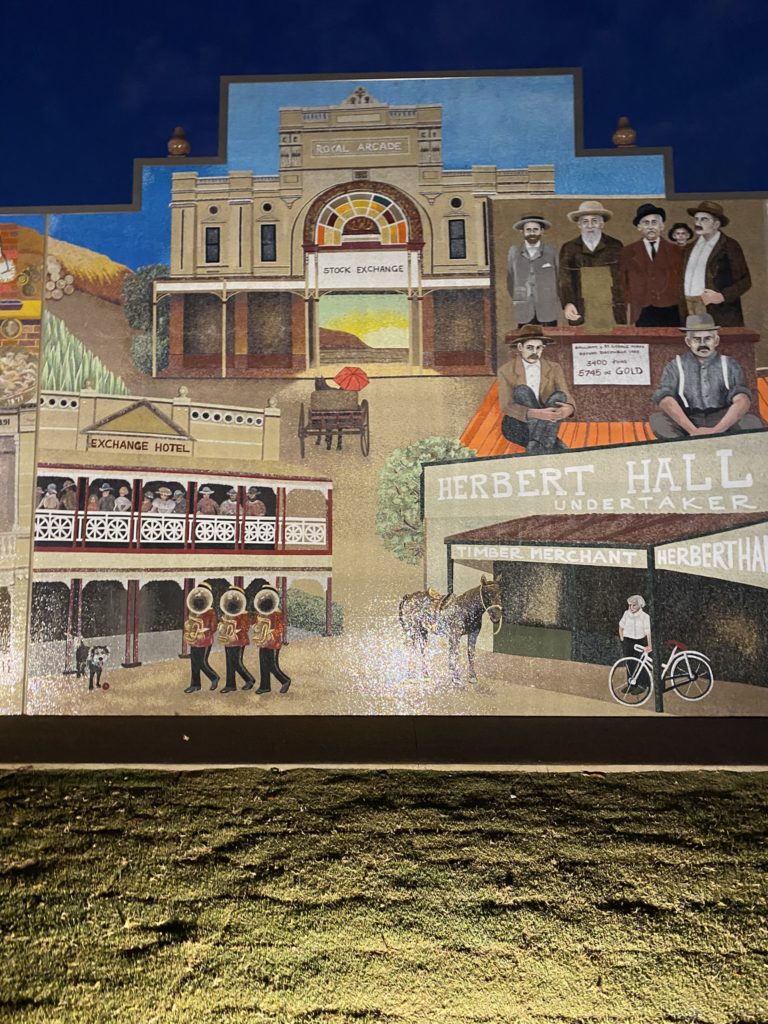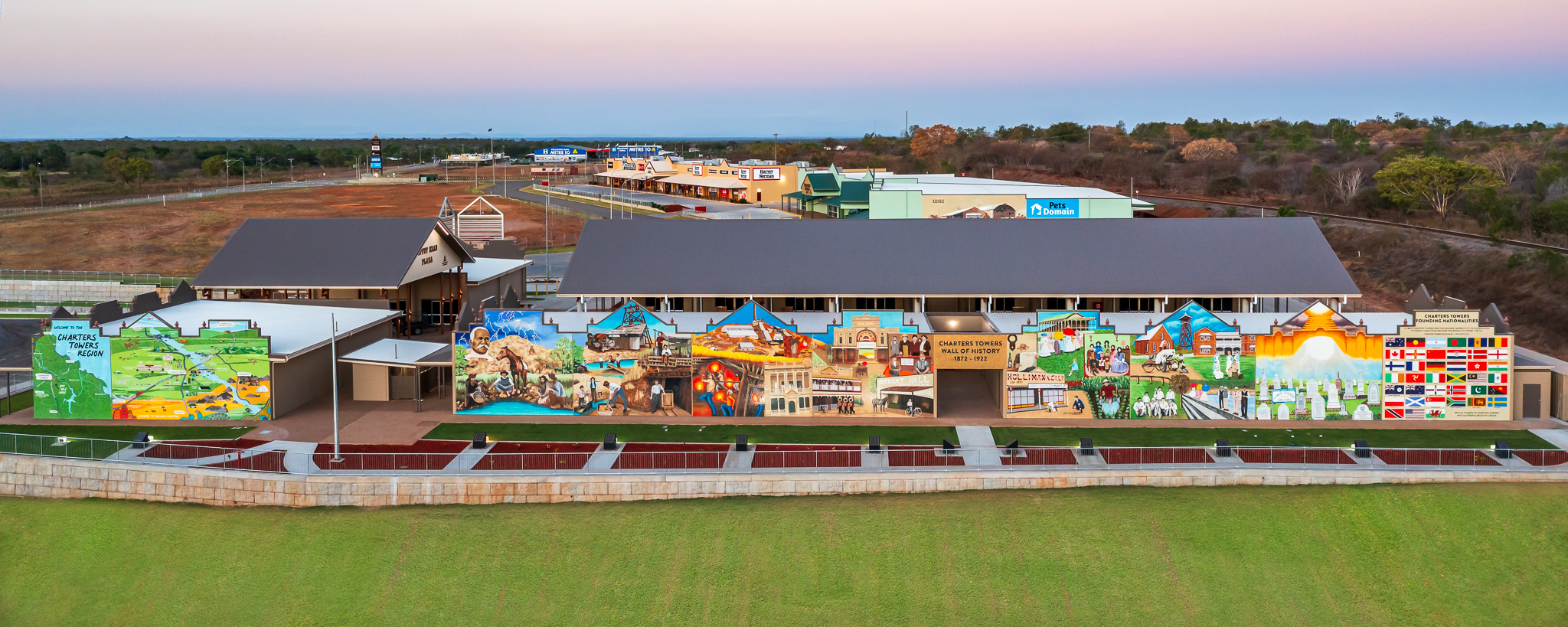Stretching seven metres tall and 80 metres in length and adorned with over five million mosaic tiles, The Wall of History stands as a captivating tribute to the pivotal moments that have shaped Charters Towers.
This awe-inspiring masterpiece was meticulously crafted to celebrate the rich history that defines the Charters Towers region today. Located along the road-side wall Poppet Head Plaza, this marvel is Australia’s largest hand-made mosaic, was inspired by the captivating story of Jupiter Mosman, an Aboriginal boy whose accidental discovery sparked the northern gold rush. This historic event propelled Charters Towers to the status of the second largest city in Queensland.
Aided by historical photos of real people and places from the local archives, award-winning fine artist Trisha Lambi beautifully created the tale as an oil on canvas before it was brought to life in mosaic form. The series depicts the Charters Towers Gold Rush across eight panels.
Amidst beautifully landscaped surroundings, plaques accompany each panel, providing insights into the history encapsulated in the imagery. Strategically placed, these plaques allow viewers to appreciate each panel individually while providing a perfect vantage point for visitors to capture each moment.





REGION MAP
The Discovery Story stars with Hugh Mosman’s prospecting party hoped to find gold in the creeks around Towers Hill, but the big summer rains had yet to arrive. Instead, Jupiter, the party’s horse boy went out and found a nice piece of stone containing gold.
The party soon found a great number of outcrops with a great quantity of surface stone showing visible gold. Such was our beginning in December 1871. The Lightning As to why Jupiter went out and found the gold, is the subject of local mythology: he was out searching for the party’s horses after they bolted, following a flash of lightning that took place on the eve of Christmas.
A deep lead find was rushed by thousands of miners from the South in late 1872. But to no avail. Quick extraction from leads or alluvial in the creeks was not how gold was to be found on the Towers. Instead, miners initially worked small claims with mates to follow outcrops of gold on the surface down into the hard rock of the goldfield. Headframes or poppet heads were raised to hoist men underground with the hope quartz bearing gold would be brought to the surface.
On the south side, there are about two feet of beautifully mineralised stone, which glitters even in the fitful light of a candle.
PYRITES WORKS – David Brown’s pyrites work on the eastern side of Towers Hill was completed at the end of 1887. The works furnace stepped down the hill as an over-capitalised and expensive means to extract gold from old tailings. Its remains are in evidence today. The utter simplicity and low cost of cyanide treatment technology introduced in 1892 made Brown’s Works redundant. In 1899 there were 96 cyaniding plants – the year of peak gold production totalling 319,572 fine ozs.
UNDERGROUND MINING – Mining is a dangerous occupation. Between 1891 and 1910, death and injury were consistently higher at Charters Towers in proportion to the number of miners employed in Queensland. Heat, hard work and poor ventilation affected the majority of miners at Charters Towers, especially at depth. Most miners suffered some form of chest trouble, which was most often known as phthisis.
ASSAYING – The most important person in a mining town is a competent assayer and metallurgist. How often is his verdict awaited with anxiety when stone has been placed in his hands? Upon the result of his analysis depends perhaps, whether this or that reef may be worked with prospects of profit.
STOCK EXCHANGE – The Stock Exchange Arcade in Mosman Street is a fine piece of architectural work and our most loved building. Its open space tiled floor and gas lighting were used by the Charters Towers Stock Exchange to encourage the public to buy and sell shares in local gold mining companies at their evening call. Fortunes were won and sometimes lost.
GOLD RETURNS – Gold mills crushed and separated out the gold from rock. Gold returns were sometimes displayed for the camera. Here the directors and shareholders of the Brilliant St George Mine joined with some of the workers at their mill at Millchester to celebrate a monthly return of 5,745 oz.
BANDS AND HOTELS – Music was everywhere. There were choirs and bands and concert groups. The Welsh held eisteddfods. Brass bands played in Lissner Park. Celebrations and commemorations were always accompanied by music and song.
HERBERT HALL – Construction was a great social and economic driver that transformed Charters Towers from bark shanties to villa residences. The likes of Ben Toll, Hugh Ross, and Herbert Hall made this possible, with wonderful examples of their work all throughout Charters Towers.
JOCKEY CLUB – Charters Towers held its first horse racing meeting in December 1872, near today’s railway station. Since then, various clubs have held meetings at Richmond Hill’s present site. The Towers Jockey Club race regularly, while the Amateur Racing Club hold their annual meeting there.
NEWSPAPERS – Charters Towers had five newspapers, which included The Northern Mine to read on a weekly basis.
MCIVER FAMILY – Paul Mclver, Founder of Goldtower Central, once went on a holiday and had a photo taken of his family in gold rush period costume. As a surprise, Mr Mclver had the photo included in this mural when he commissioned it. Needless to say, the family were indeed very surprised!
HOLLIMANS E Construction was a great social and economic driver that transformed Charters Towers from bark shanties to villa residences. The likes of Ben Toll, Hugh Ross, and Herbert Hall made this possible, with wonderful examples of their work throughout Charters Towers.
CHURCHES – Christian faith was widely practiced in a number of denominational churches throughout the city. The German Lutherans built their house of worship in Anne Street, unusually, out of brick. The bell tower stands as a reminder of the mining headframes that once covered the area.
HOSPITAL – The hospital occupies an excellent town site in Gill Street. It has quite the best operating theatre in the State. It has room for 100 in-patients with 1,010 admitted during the year. There are four honorary surgeons and two honorary dentists. The patients, without exception, speak in high terms of their treatment (1901).
CRICKET – The hot weather of summer always brings out men, women and children to play cricket. A hundred years ago, games were played between local teams and Indigenous men who were in town from the cattle stations for holidays, to raise money for the city’s hospital.
THE WEIR – The Weir was barely finished on 22 November 1902 when floodwaters came down the Burdekin River. Soon after midnight, a black, horrid-looking mass, quickly filled the weir. The three-year Federation drought was finally broken. With the Weir wall raised in 1996, the city of Charters Towers is now drought-free.